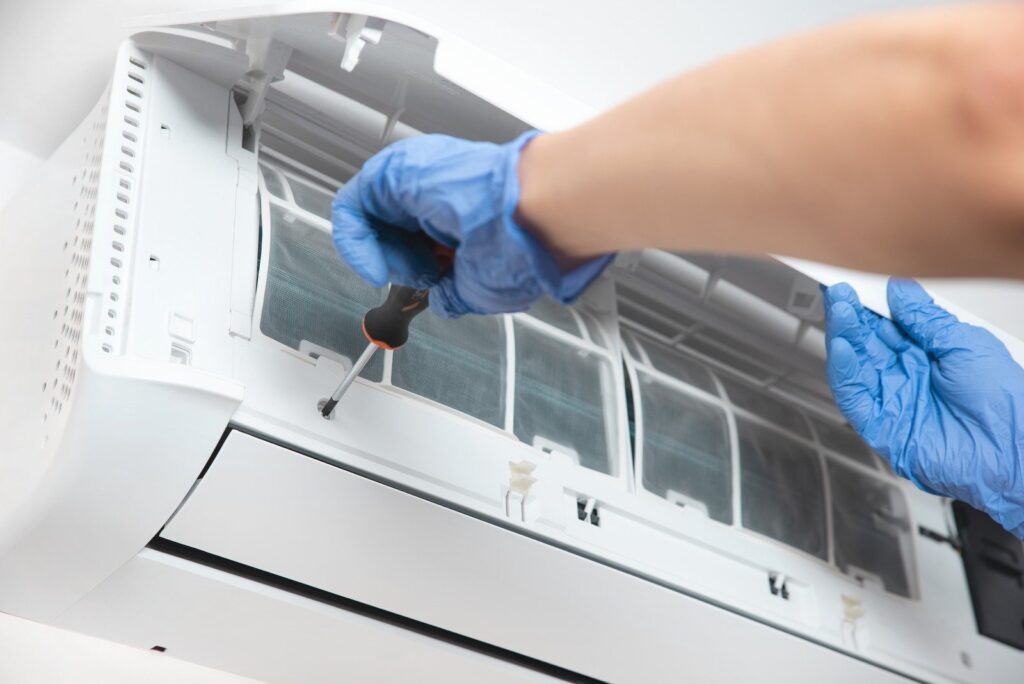
Common AC Issues Leading to Repair
Maintaining an efficient air conditioning (AC) system is crucial for ensuring indoor comfort and cost-effectiveness. Recognizing common AC problems early on can help prevent major breakdowns and expensive repairs, highlighting the importance of routine maintenance and prompt troubleshooting. In this article, we will explore five prevalent issues that often lead to the need for AC unit repair, providing insights on troubleshooting and addressing these common issues effectively.
When your AC is blowing warm or hot air, it can be a frustrating experience, especially during the sweltering summer months. This issue commonly arises due to improper thermostat settings or a clogged air filter [1]. For instance, a clogged air filter restricts airflow, causing the system to work harder and potentially overheat, leading to warm air being circulated throughout your home. By regularly checking and replacing air filters, you can ensure proper airflow and prevent your AC from blowing warm air unnecessarily, ensuring efficient cooling performance.
Additionally, low refrigerant levels are a common culprit behind AC units blowing warm air. Refrigerant is essential for the cooling process, and insufficient levels can hinder the system’s ability to produce cold air effectively. If you notice warm air coming from your vents, it may indicate a refrigerant leak or simply a need for a recharge. Consulting with a professional to assess and address the refrigerant levels can help restore your AC’s cooling efficiency and ensure your home stays comfortably cool during hot weather.
AC Not Working at All
When your AC unit fails to work altogether, several common issues may be at play. Problems with thermostat batteries or malfunctioning circuit breakers are frequent culprits for complete AC failure. For instance, if the thermostat is not set to “cooling” or if the circuit breaker is tripped, the AC unit might not turn on as expected. Moreover, power supply problems or internal component failures within the AC system can also result in the unit not working as intended. Regularly checking the thermostat settings, ensuring the circuit breaker is functioning correctly, and inspecting electrical connections can help in identifying potential issues early on and prevent sudden breakdowns.
To illustrate, imagine coming home on a scorching summer day only to find your AC unit unresponsive. By troubleshooting the thermostat settings and verifying the circuit breaker status, you might discover that a simple adjustment or reset can resolve the issue promptly. Furthermore, scheduling routine inspections of electrical connections and components can help detect any underlying problems before they escalate into major malfunctions, thereby ensuring your home stays cool and comfortable throughout the hottest months.
AC Blowing Warm or Hot Air
When faced with the frustration of your AC system blowing warm or hot air instead of the desired cool breeze, it’s crucial to troubleshoot the issue promptly. One common culprit for this discomfort is incorrect thermostat settings or a dirty, clogged air filter. Picture this scenario: on a scorching summer day, you adjust your thermostat to a refreshing temperature, but warm air continues to flow, leaving you sweltering indoors due to a simple thermostat misconfiguration or a neglected air filter.
Moreover, inadequate refrigerant levels often contribute to AC units emitting warm air and struggling to maintain optimal cooling performance. For instance, imagine coming home on a sultry afternoon, expecting a blast of cool air from your AC unit, only to be greeted by lukewarm temperatures due to insufficient refrigerant levels. Regular maintenance routines that include checking refrigerant levels can be the key to rectifying this issue and ensuring your AC system operates efficiently, providing the much-needed respite from the heat.
Leaky AC Unit
When dealing with a leaky AC unit, it is essential to understand the potential consequences of ignoring the issue. Leaks can result in water damage and even mold growth within the AC system, posing health risks and further damaging the unit. For instance, a clogged condensate line can cause water to back up and overflow, leading to leaks and potential water damage.
To address a leaky AC unit effectively, it is advisable to enlist the services of professionals who can diagnose the root cause of the leak. By identifying and repairing issues such as damaged seals or clogs in the condensate line, technicians can prevent further damage and ensure the efficient operation of the AC unit. Taking proactive steps to address leaks promptly can help homeowners avoid costly repairs and maintain a healthy indoor environment.
Uneven Temperature Distribution in the Home
Uneven temperature distribution in the home can lead to discomfort and frustration, especially when certain areas are noticeably warmer or cooler than others. This issue commonly arises due to poor insulation that allows heat transfer, resulting in temperature variations across different rooms. For instance, rooms with inadequate insulation may heat up faster during the day, causing uneven cooling when the air conditioning system is running.
To address this problem effectively, homeowners can consider installing dampers in the ductwork of their HVAC system. Dampers are devices that help control and redirect airflow to specific areas of the house, allowing for a more balanced distribution of cooled air. By adjusting the dampers, residents can regulate the amount of air entering each room, thereby improving temperature consistency throughout the home. Additionally, investing in proper insulation for walls, floors, and attics can significantly reduce heat transfer, helping to maintain a comfortable and even temperature indoors.
By taking these steps to enhance airflow balance and insulation, homeowners can create a more comfortable living environment while also improving the energy efficiency of their homes. This proactive approach not only promotes consistent cooling but also contributes to cost savings on energy bills by optimizing the performance of the air conditioning system.
Noisy AC Unit
When it comes to an AC unit producing loud noises, it’s essential to understand that these sounds can be a red flag for underlying issues with critical components like the fan, compressor, or motor. For instance, a squealing noise may indicate a worn-out belt, while grinding noises could point to motor issues. By addressing these unusual sounds promptly, homeowners can prevent more severe damage to their AC system and avoid costly repairs down the line.
Regular maintenance routines play a crucial role in minimizing excessive noise from an AC unit. Keeping the unit clean and free from debris buildup not only ensures optimal performance but also reduces the chances of noisy operation. Moreover, scheduling professional inspections for any persistent or unfamiliar noises can provide a thorough diagnosis of the problem, allowing for timely repairs and the preservation of the AC unit’s longevity. Remember, a well-maintained AC system operates more quietly, contributing to a peaceful and comfortable indoor environment.
Oxford’s #1 AC Unit Repair Service
At Clean Air Solutions, we understand the importance of a functioning AC unit, especially during the hot Mississippi summers. If you’re in need of an ac unit repair contractor to deal with any AC issues mentioned in our blog post or an ac unit replacement, don’t hesitate to reach out to us. Our team of experienced technicians is ready to diagnose and repair your AC unit promptly, ensuring your home stays cool and comfortable all season long. Don’t let AC problems disrupt your comfort—schedule your repair service today and let Clean Air Solutions keep your home cool and refreshing.
Clean Air Solutions Oxford MS
Serving Oxford, Abbeville, Water Valley, Batesville, and Springdale, MS
(662) 816-9197
